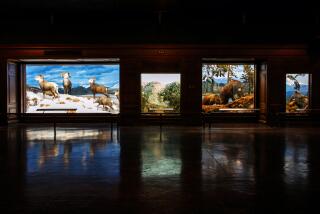Video Artist Bill Viola Tinkers With Technology in Conveying His Ideas
When video artist Bill Viola was an art student, he was obliged to take a traditional class in life drawing. But his passion was electronic media; he had no patience for drawing. So he made a videotape of the model and traced her contours on the monitor.
“It didn’t go over very well,” the amiable, bearded artist admitted in an informal lecture Tuesday night at Newport Harbor Art Museum, which owns and is exhibiting his “Theater of Memory” installation piece.
For Viola, whose years at Syracuse University in the early ‘70s coincided with the flowering of art video, the “exuberance” of the medium was a heady thing. Up until the late ‘60s, video cameras were massive devices that cost as much as $100,000. Then came the Portapak, a comparatively lightweight video camera.
But the equipment was still expensive, and Viola’s student years were spent camped out at the university video center late at night, the sole block of time not reserved by hordes of other video nuts. He described how he struggled to master the mechanics of the medium so he could use it as an “invisible” vehicle for art--much as a pianist begins with the “tedious awkwardness” of scales and finally winds up “playing this thing called music.”
Music is a key analogy for Viola, whose work--which doesn’t tell a story in the conventional sense--is based on the split-second editing of images and sounds into specific rhythms and repeats.
Produced in 1976, “The Space Between the Teeth”--which Viola teasingly called “the deranged ravings of a 25-year-old mind”--marked the first time he felt he was able to “precisely define sections of time” with his medium of choice.
In the 9-minute video, Viola sits down in a large armchair. And sits. And sits. Suddenly he screams. And screams. And screams. The camera tracks away from him, moving swiftly down a long corridor, while the faint sounds of screams continue.
When he becomes an almost indecipherable object in the far distance, the camera hurtles back with jerky suddenness to close in on his screaming mouth. Eventually, the image of Viola screaming becomes a photograph adrift on a body of water, flipped over by the wake of an unseen passing boat.
Viola said the piece was made at a “very low point in my life, when I really didn’t think I had any ideas.” Then one day, he felt like screaming. And a video idea was born.
“I began to think of the sound (of the scream) as the center of that experience. So that’s where the camera had to be--the camera rushes in to meet the scream.”
But artistic ideas in video always hinge on technology: waiting for it to catch up and then gaining access to it. Computer editing devices were not widely available until 1972, and even then an artist either needed to be an artist-in-residence at a TV studio or pay exorbitant rates to rent a professional lab. So Viola realized that he had to visualize each second of tape before even setting foot in a studio.
After showing more recent tapes, Viola answered questions.
“I barely understand what you are working with,” one middle-aged woman said. “I didn’t grow up with TV. I can barely operate my VCR.”
Viola was sympathetic. “At this point in history, when you move away from what you can do and feel and touch with your hand, it feels unnatural,” he said. “I think of it as Orville and Wilbur Wright stuff, though. Even a VCR is so incredibly primitive. (Someday) we’ll look back and say, ‘People were watching images on that thing?’ ”
More to Read
The biggest entertainment stories
Get our big stories about Hollywood, film, television, music, arts, culture and more right in your inbox as soon as they publish.
You may occasionally receive promotional content from the Los Angeles Times.










